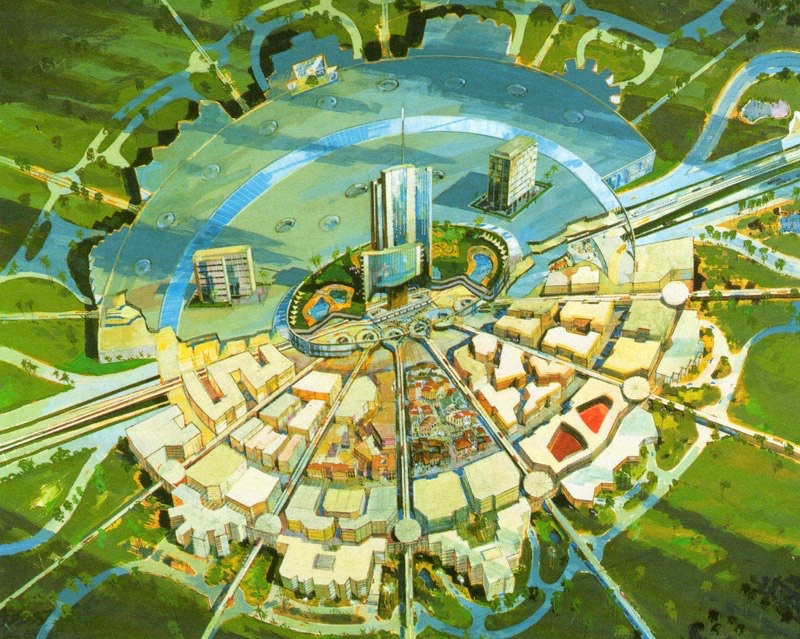- Written by Ankitha Gattupalli
- August 29, 2022
- https://www.archdaily.com/987892/epcot-walt-disneys-new-urbanist-city?utm_medium=email&utm_source=ArchDaily%20List&utm_campaign=weekly&kth=6,645,594
Beneath the Spaceship Earth geodesic sphere and the display of world cultures that symbolize Disney World’s EPCOT lies the buried vision for a utopian city. The original EPCOT – a community built around innovation – was one of Walt Disney’s last visionary projects. Bothered by haphazard urban sprawl,Disney had bold ideas for an urban fabric that would drive progress in the USA. The “Experimental Prototype Community of Tomorrow” was Walt Disney’s antidote to the decay of American cities.
On October 26, 1966 – a period well into the United States’ modernist movement – Walt Disney released a film that narrated his plans for a futuristic prototype city. EPCOT was his dream for a technologically-forward and green society in the USA. The experiment would fuse Disney’s revolutionary visions in urban planning, re-examining how American cities could develop in a controlled manner. Disney strongly believed that the problems of cities were the most critical issues facing society.

The entrepreneur wished to leave a legacy behind using his amassed knowledge on planning from his projects Disneyland, the California Institute of the Arts, and more. He worried that modern cities were in a state of decay, feeling that they “were hectic, disorganized, dirty, and crime-ridden.” Walt Disneyspent the last few months of his life deeply engrossed in the urban planning project, passing away in December of that year. The original vision for EPCOT passed with him.
Related Article
Exploring New Urbanism Principles in the 21st Century
For reasons around the impracticality of maintaining, governing, and operating the city, Walt DisneyProductions scrapped the idea after Disney’s death. Today, Disney World’s EPCOT is a theme park that fits the entire world on 305 acres. Located in Florida, USA, the center showcases international cultures and forward-thinking ideas to over 12 million visitors annually. This permanent world fair is far from the initial blueprints for EPCOT, although it holds some traces of Walt’s intentions. The present-day amusement park offers glimpses into Disney’s human-centric design approach and what he believed cities could be with proper planning and design.

The original idea for EPCOT was a radially planned city with a nuclear 50-acre domed megastructure. The circumference would house people in high-density apartments and single-family houses. Bridging the urban and suburban areas was a web of electric monorails and PeopleMovers, traveling across a greenbelt in between. The climate-controlled center would host international corporations, a convention center, and a 30-storied cosmopolitan hotel while the downtown would feature a weather-protected zone of themed shops.
The spire-like hotel would tower over the city, serving as a landmark and an urban focal point. Beneath the buildings would run a network of roads for electric trucks and vehicles. The ground-level streets would be framed by human-scaled structures designed to inspire and amuse pedestrians, maintaining Eyes on the Street with balconies and terraces overhead. The greenbelt would serve as a central park for the city, dotted with schools, churches, and recreational centers.


Walt Disney had a human-centered approach to both his films and construction projects and was able to empathize with the people’s needs. The philosophy behind EPCOT was ahead of its time, preceding the later established principles of New Urbanism: walkability, connectivity, smart transportation, sustainability, and quality of life. The USA-born movement arose in the early 1980s as a reaction to urban sprawl caused by cities designed for automobiles – a sentiment Disney echoed. His New Urbanist concept eradicated the need for cars and proposed a mixed-use town center, increased density, and compact living.
The design for the futuristic city sees influences from many pertinent urban planners and thinkers. The Heart of Our Cities by Victor Gruen was found on Disney’s bookshelf and the book’s ideas in his designs. Victor Gruen was the architect behind the first suburban shopping mall, a radical urban design in the 1950s. He was also concerned about the effect of urban sprawl on the vitality of American cities.
The architect theorized the “cellular metropolis” – a suburb divided into smaller community “cells” encircling an indoor shopping mall “nucleus”. Apartments and office buildings would surround the bustling hub to create a vital community center. EPCOT closely mirrors the cellular metropolis model with its central commercial district enveloped by high-density structures. Disney’s proposal also mimics Gruen’s covered hubs to support pedestrians by extending the desirable walking range in Florida’s wet weather.


The radial plan of EPCOT seems borrowed from Ebenezer Howard’s Garden Cities of Tomorrow. Howard’s prototype similarly promotes satellite communities banding a central city, separated by greenbelts. The human-scaled community also holds similarities to Le Corbusier’s Radiant City, both sharing an interest in innovative transportation, logically planned green neighborhoods, high-density housing, and a strict division of commercial, entertainment, and residential areas. Walt Disney seemed to have understood the Timeless Way of Building and ideals of architectural beauty, concepts put forward by Christopher Alexander. The Disney parks are unanimously considered “places where you feel yourself, places where you feel alive”, in the words of Alexander.
For its time, EPCOT was a fairly sustainable design. The compact city was an agglomeration of destination nodes, each joined by a high-capacity electronic rail that yielded personal vehicles useless. Planned with plenty of open space, the greenbelts would foster the growth of a variety of flora and fauna. The center followed the patterns of proper transit-oriented development, designed density, and diversity.

Although the original EPCOT was never built, the theme park continues to inspire city planners and urban designers. Disney’s simple yet impactful people-centered urban planning approach creates timeless spaces that cut across cultures and age groups. From his movies to his theme parks, Disney’s primary motive was to bring people joy. The lost model of EPCOT highlights that cities should be built with concern for the people, as “the happiest place(s) on Earth”.




